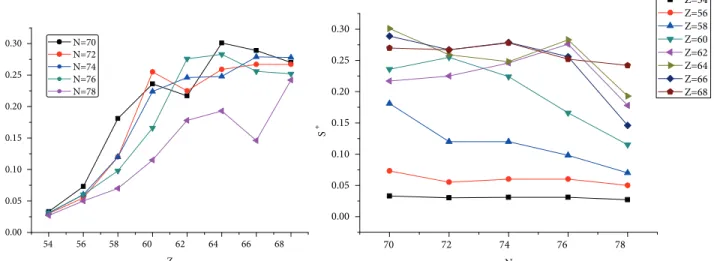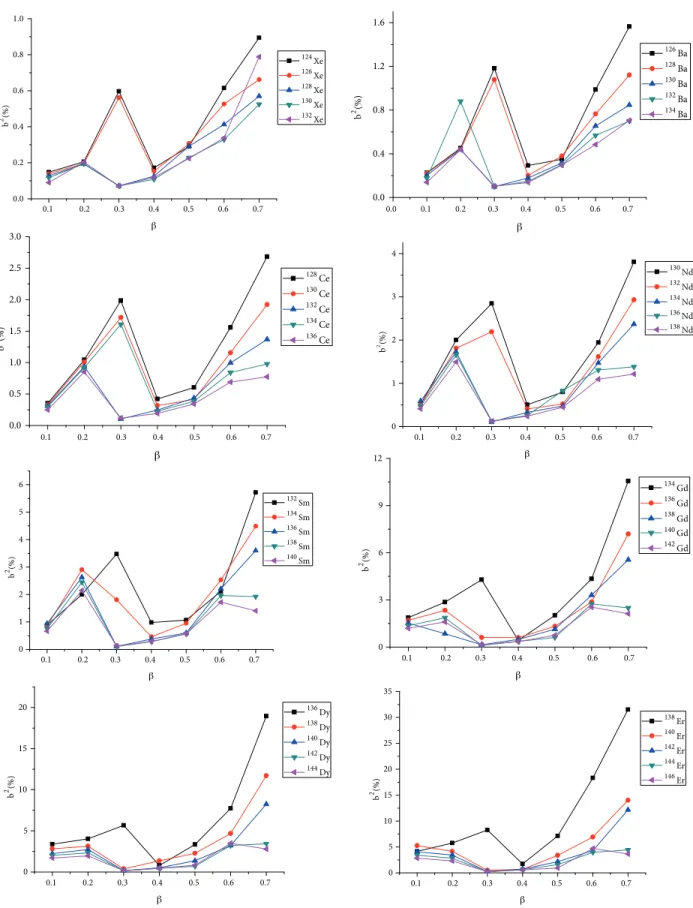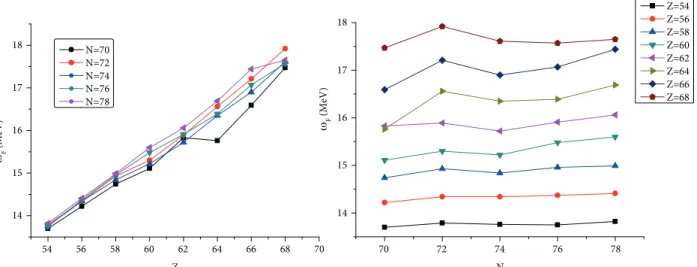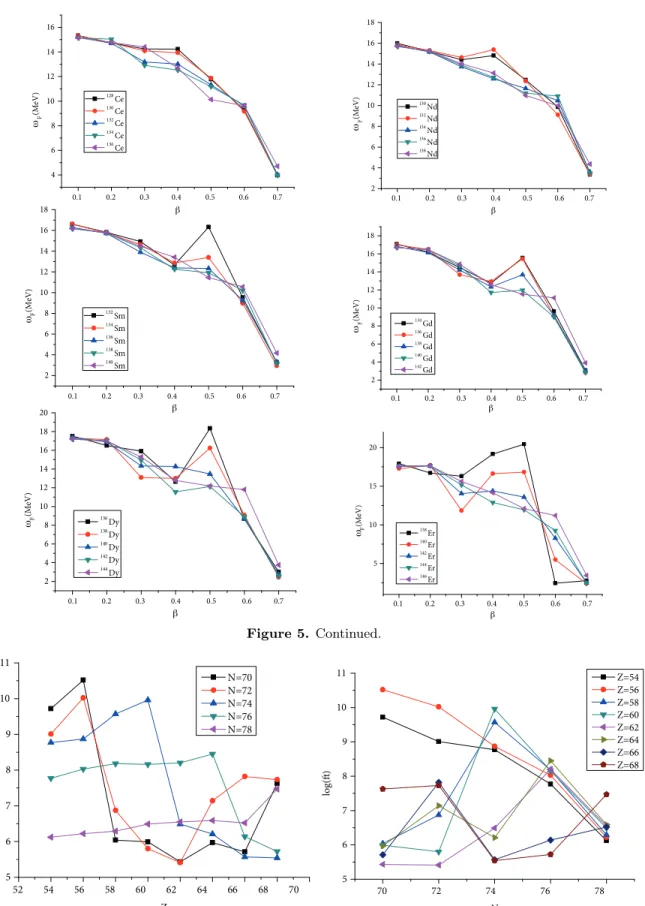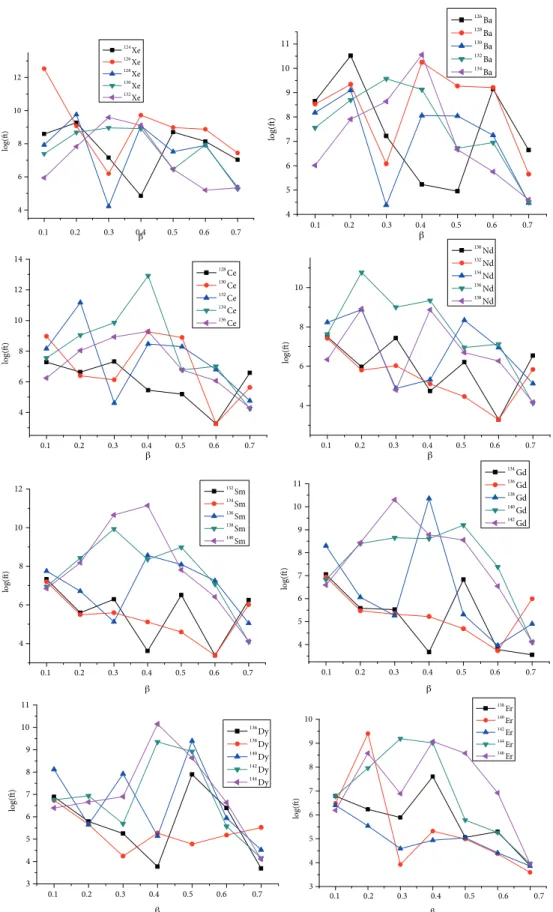c
⃝ T¨UB˙ITAK
doi:10.3906/fiz-1604-22 h t t p : / / j o u r n a l s . t u b i t a k . g o v . t r / p h y s i c s /
Research Article
Isospin mixing and Fermi transitions for some deformed nuclei
Serdar ¨UNL ¨U1,∗, Hasan Ali AYG ¨OR1,2, Necla C¸ AKMAK1,3, Cevad SELAM1,2
1Department of Physics, Faculty of Arts and Science, Mehmet Akif Ersoy University, Burdur, Turkey 2
Department of Physics, Faculty of Arts and Science, Mu¸s Alparslan University, Mu¸s, Turkey
3Department of Physics, Faculty of Science, Karab¨uk University, Karab¨uk, Turkey
Received: 19.04.2016 • Accepted/Published Online: 23.05.2016 • Final Version: 01.12.2016
Abstract: We have tried to give a self-consistent explanation of isospin mixing and Fermi beta decays for 54 ≤ Z ≤ 68 deformed nuclei. The effect of isospin impurity in nuclear ground states on Fermi beta transitions has been investigated considering the restoration of symmetry violations stemming from the mean field approximation. The isobar analogue excitations in neighbor odd-odd nuclei have been obtained by following the proton-neutron quasiparticle random phase approximation (pnQRPA) procedure. The dependence of isospin admixture probability on the deformation parameter has been determined for various isotopes of Z = 54–68 nuclei. Then the variations of isobar analogue state energies and the β decay log(ft) values with deformation parameter have been calculated for the same nuclei. Thus, the influences of the isospin symmetry violations on Fermi transitions can be clearly understood.
Key words: Isospin symmetry, pnQRPA
1. Introduction
It is well known that the isospin symmetry is largely preserved by strong interactions. A small symmetry violation at the hadronic level is due to the difference in the masses of the up and down quarks [1]. In atomic nuclei, the main source of isospin symmetry breaking is the electromagnetic interaction [2,3]. The isovector and isotensor parts of electromagnetic force are much weaker than strong interactions between nucleons, so the effects of isospin symmetry breaking can be considered in a perturbative way. Hence, the formalism related to isospin is a very powerful concept in nuclear structure and reactions [4,5].
The investigation of Fermi beta decay is very important in understanding the isospin impurity in nuclear ground states. The problem of isospin mixing in nuclear ground states is of great importance in the experimental determination of the vector coupling constant of nucleon β -decay as well as in the description of the isobar analogue state energies and isospin multiplets [6–9]. The isospin mixing in nuclear ground states was studied in various models. The two-liquid hydrodynamic model was used to estimate the energies of the collective isovector
monopole excitation with an isospin of T = T0+ 1 [10]. The admixture of this excited state to the ground state
with an isospin of T = T0, caused by the Coulomb potential, turned out to be small (0.1–0.3) for all stable
nuclei with A > 40. Quantitative estimates performed by using the shell model [11–13] are approximately one order of magnitude larger than the estimate of Bohr and Mottelson. There are several factors that may cause such a difference in the mentioned estimates. First, the shell model calculations were performed in the particle-hole approximation and used a limited number of configurations. Second, the residual isovector interaction ∗Correspondence: serdarunlu@mehmetakif.edu.tr
was either neglected or included in the Tamm–Dankoff approximation. Third, the residual interaction was not related to the shell model potential in a self-consistent way. The isospin mixing for the proton-rich nuclei between A = 80 and A = 100 was calculated [14–24]. The Hartree–Fock calculations for these nuclei predicted the isospin mixing in the order of 0.03–0.05 [17]. The isospin mixing increased by an amount of 0.15–0.20 within the random phase approximation [14].
As known, the symmetry properties of the total nucleus Hamiltonian are violated in the mean field approximation. These violations have remarkable effects on the single and double beta decay rates [25–32]. The
observation of Fermi β+ decay in neutron-excess nuclei can be attributed to the isospin symmetry violations
stemming from the electromagnetic interactions. In other words, the total β+ decay probability, which is directly
related to the isospin impurity in the ground state, would be zero if the isospin symmetry was an exact symmetry of the total nucleus Hamiltonian. However, the symmetry violations in the mean field level of approximation
lead to an increment in the total β+ decay probability. Therefore, the restoration of these symmetry violations
has importance in determining the beta decay properties. The calculation of Fermi transitions with and without Coulomb interaction may be an efficient way to understand the isospin symmetry breaking effects [25], but a more realistic approximation should be used to define the transition properties. The isospin symmetry violation
in the mean field approximation should be eliminated in a self-consistent way. The investigation of these
transitions within a self-consistent method that is used to restore the symmetry violations stemming from the mean field approximation ensures that we can understand the decay properties more clearly. The calculation of Fermi decays for the systems with different proton numbers helps us to understand isospin symmetry breaking effects on these decays. The calculation of these decays for different deformation parameters clearly exhibits the symmetry breaking effects due to the sensitivity of the isospin impurity in nuclear ground states to this parameter. The isospin violation in the mean field level for neutron-excess nuclei was eliminated within the nuclear density functional theory [27]. A significant dependence of the magnitude of isospin breaking on the parametrization of the nuclear interaction term was found by the Warsaw group. Hence, the nucleon-nucleon residual interaction potential should be included in such a way that the isospin symmetry violation in the mean field level is restored. Pyatov’s restoration method is an efficient way for such a restoration [26,31–38]. This method was used to investigate the isospin mixing and isobar analogue states for spherical nuclei [26,37,38]. Here Pyatov’s method is applied for the investigation of isospin impurities and Fermi beta decays of various deformed
nuclei (54 ≤ Z ≤ 68). There have been no theoretical analyses or experimental data on the isospin mixing ratios
and Fermi transitions for these nuclei. A self-consistent explanation of isospin mixing and Fermi decays for the nuclei is given in the present work. In this respect, the symmetry violations that originate from the mean field approximation have been eliminated using Pyatov’s restoration method and the isobar analogue excitations in neighbor odd-odd nuclei have been described without using any adjustable parameter. The probabilities for isospin mixing in the ground state of parent nuclei have been determined for the nuclei under consideration. The variation of the isospin admixture probability with the deformation parameter has been calculated and then the dependence of isobar analogue state energies and β -decay log(ft) values on the same parameter has been studied. Thus, the influences of isospin impurity in the ground state of the parent nucleus on Fermi transitions can be understood. The details of restoration are given in the next section. Section 3 contains the calculated results for the isospin mixing and Fermi beta transitions for deformed Z = 54–68 nuclei.
2. Method
The Fermi β -decay operators are described as:
T+= A ∑ i=1 t+(i) (1) T−= (T+)†.
Let us define a new charge exchange operator as below:
Fρ=1
2 (
T++ρT−) (ρ =±). (2)
The single quasiparticle Hamiltonian is defined as follows:
Hsqp=
∑
sσ
εs(τ ) α†sσ(τ ) αsσ(τ ) (τ = n, p), (3)
where εs(τ ) is the single quasiparticle (sqp) energy, and α†sσ(τ ) ( αsσ(τ )) is the quasiparticle creation
(anni-hilation) operator. Let us note that the n and p abbreviations are used instead of snand sp, respectively. The
nuclear part of the total Hamiltonian must commute with the Fermi β -decay operator
[H− VC, Fρ] = 0, (4)
but this commutativity is broken in the mean field approximation as below:
[Hsqp− VC, Fρ]̸= 0, (5)
where V c is the Coulomb term of a deformed Woods–Saxon potential [39].
The isospin invariance of the nuclear part broken in the mean field level of the approximation can be restored by including an effective interaction potential defined as below:
h =∑
ρ
1 4γρ
[Hsqp− VC, Fρ]†• [Hsqp− VC, Fρ] . (6)
The effective interaction constant is found from the following condition,
[Hsqp− VC+ h, Fρ] = 0, (7)
and taken out to be a free parameter.
γρ=⟨0 | [[Hsqp− VC+ h, Fρ] , Fρ]| 0⟩ . (8)
The pnQRPA Hamiltonian for the investigation of the isobar analogue states is described as follows:
H = Hsqp+ h. (9)
The phonon creation operator for the isobar analogue states is described as:
|i⟩ = Q†i|0⟩ =
∑
np
where Cnp† ( Cnp) is the quasiboson creation (annihilation) operator, and ψinpand φinp are the forward and
backward amplitudes, respectively. The following equation is solved to obtain the energies and wave functions of the isobar analogue excitations:
[
Hsqp+ h, Q†i
]
|0⟩ = ωiQ†i|0⟩ , (11)
where ωicorresponds to the excitation energies for the isobaric analogue states.
The total β decay strength for Fermi transitions is given as follows:
S± =∑ i Mi β±(0 + g.s → 0 + i ) 2, (12) Mβi±(0+g.s→ 0 + i ) = ⟨ 0|[Qi, T± ] | 0⟩.
These strengths must fulfill the sum rule in the following form:
S−− S+= N− Z. (13)
The probability of isospin mixing in the ground state of the parent nucleus is calculated by using Eq. (14):
b2= 1 2(T0+ 1) ∑ i Mi β+ 2 , (14) T0= N− Z 2 .
3. Results and discussion
The isospin admixture probabilities in the ground states of deformed Z = 54–68 nuclei and Fermi β transitions are calculated by using Pyatov’s restoration method within the framework of pnQRPA formalism. The Nilsson single particle energies and wave functions are calculated within the deformed Woods–Saxon potential [39,40]. All energy levels up to 8 MeV are considered for neutrons and protons. The proton and neutron pairing gaps
are determined as ∆p=Cp
/√
A and ∆n=Cn
/√
A MeV, respectively [41]. The pairing strength parameters
( Cp and Cn) are chosen so that the experimental pairing gaps are reproduced [42]. The fixed values of pairing
interaction and the corresponding β transition strengths are presented in the Table. The present deformations in the 2nd column are determined from the single particle energies as shown in [43].
The calculated probabilities for the isospin mixing in nuclear ground states are given in Figure 1. The upward and downward figures represent the results of the restoration method and a phenomenological formula [ b2= 3.5× 10−7Z2A2/3(T
0+ 1)−1] [41], respectively. The curves obtained in both methods almost exhibit the
same behavior as Z and N, but the calculated probabilities within restoration are approximately three times larger than those obtained with the phenomenological formula. The difference between the present calculations
and the phenomenological formula originates from the variation of β+ transition probability (see Eq. (14))
with proton and neutron number (see Figure 2). As expected, the β+ decay probability usually decreases
with N and increases with Z. The fluctuations in curves can be attributed to the differences in deformation effects. In order to understand the deformation effects on the isospin impurities, the dependence of the isospin
Table. The calculated values of β− and β+ decay strengths.
Nuclei β Cn(MeV) Cp(MeV) S− S+ S−- S+ N - Z
124Xe 0.18 10.80 10.69 15.976 0.033 15.943 16 126Xe 0.16 11.24 10.71 17.974 0.030 17.944 18 128Xe 0.15 11.51 10.94 19.862 0.031 19.831 20 130Xe 0.13 12.06 11.50 22.167 0.031 22.136 22 132Xe 0.11 12.72 12.10 24.010 0.027 23.983 24 126Ba 0.20 9.68 11.14 13.920 0.073 13.847 14 128Ba 0.17 10.06 11.20 15.857 0.055 15.802 16 130Ba 0.16 10.64 11.40 19.590 0.060 19.530 18 132Ba 0.14 10.80 11.82 20.020 0.060 19.960 20 134Ba 0.12 10.53 12.70 22.020 0.050 21.970 22 128Ce 0.22 9.49 11.54 10.965 0.181 10.784 12 130Ce 0.18 9.65 11.65 13.980 0.120 13.860 14 132Ce 0.17 9.94 11.93 16.110 0.120 15.990 16 134Ce 0.15 10.20 12.40 18.525 0.098 18.427 18 136Ce 0.12 10.97 12.98 19.981 0.070 19.911 20 130Nd 0.24 9.67 10.28 10.265 0.236 10.029 10 132Nd 0.20 9.81 10.72 12.200 0.255 11.945 12 134Nd 0.18 9.65 12.44 14.197 0.224 13.973 14 136Nd 0.15 9.96 12.83 16.102 0.166 15.936 16 138Nd 0.12 9.95 14.10 17.842 0.115 17.727 18 132Sm 0.21 9.65 10.12 8.247 0.217 8.030 8 134Sm 0.21 9.91 10.23 10.286 0.225 10.061 10 136Sm 0.216 9.61 11.96 12.351 0.246 12.105 12 138Sm 0.16 9.60 12.84 14.270 0.276 13.994 14 140Sm 0.12 9.90 14.41 16.264 0.178 16.086 16 134Gd 0.26 9.57 10.16 6.330 0.301 6.029 6 136Gd 0.22 9.76 10.34 8.033 0.259 7.774 8 138Gd 0.19 9.56 11.18 10.289 0.248 10.041 10 140Gd 0.21 9.37 12.28 12.405 0.283 12.122 12 142Gd 0.10 9.90 14.44 14.201 0.193 14.008 14 136Dy 0.26 9.57 9.42 4.344 0.289 4.055 4 138Dy 0.22 9.69 9.60 6.204 0.267 5.937 6 140Dy 0.21 9.62 9.89 8.261 0.279 7.982 8 142Dy 0.18 9.32 11.31 10.264 0.256 10.008 10 144Dy 0.06 9.96 13.99 12.177 0.146 12.031 12 138Er 0.25 9.64 8.14 2.369 0.270 2.099 2 140Er 0.22 9.60 8.31 4.137 0.267 3.870 4 142Er 0.20 9.65 8.94 6.140 0.278 5.862 6 144Er 0.16 9.24 10.53 8.229 0.252 7.977 8 146Er 0.16 9.97 12.63 10.292 0.242 10.050 10
admixture probability on the deformation parameter should be calculated for each isotope. Thus, the variation of the isospin mixing with the deformation parameter is presented in Figure 3. The isospin impurity in nuclear ground states originates from the variable part of Coulomb potential. In other words, the probability for the isospin mixing would be zero if Coulomb potential was constant in nuclear volume. In a deformed structure, the variable part of Coulomb potential is proportional to the quadratic part of the deformation parameter.
54 56 58 60 62 64 66 68 70 0 1 2 3 4 5 6 7 b 2 (% ) Z N=70 N=72 N=74 N=76 N=78 70 72 74 76 78 0 1 2 3 4 5 6 7 b 2 (% ) N Z=54 Z=56 Z=58 Z=60 Z=62 Z=64 Z=66 Z=68 54 56 58 60 62 64 66 68 0.0 0.5 1.0 1.5 2.0 2.5 b 2(% ) Z N=70 N=72 N=74 N=76 N=78 70 72 74 76 78 0.0 0.5 1.0 1.5 2.0 2.5 b 2 (%) N Z=54 Z=56 Z=58 Z=60 Z=62 Z=64 Z=66 Z=68
Figure 1. The variation of isospin admixture probability with the proton and neutron number.
54 56 58 60 62 64 66 68 0.00 0.05 0.10 0.15 0.20 0.25 0.30 S + Z N=70 N=72 N=74 N=76 N=78 70 72 74 76 78 0.00 0.05 0.10 0.15 0.20 0.25 0.30 S + N Z=54 Z=56 Z=58 Z=60 Z=62 Z=64 Z=66 Z=68
0.1 0.2 0.3 0.4 0.5 0.6 0.7 0.0 0.2 0.4 0.6 0.8 1.0 b 2(% ) β 124Xe 126 Xe 128 Xe 130Xe 132 Xe 0.0 0.1 0.2 0.3 0.4 0.5 0.6 0.7 0.0 0.4 0.8 1.2 1.6 b 2(% ) β 126 Ba 128 Ba 130 Ba 132 Ba 134 Ba 0.1 0.2 0.3 0.4 0.5 0.6 0.7 0.0 0.5 1.0 1.5 2.0 2.5 3.0 b 2(%) β 128 Ce 130 Ce 132 Ce 134 Ce 136 Ce 0.1 0.2 0.3 0.4 0.5 0.6 0.7 0 1 2 3 4 b 2(% ) β 130 Nd 132Nd 134 Nd 136Nd 138Nd 0.1 0.2 0.3 0.4 0.5 0.6 0.7 0 1 2 3 4 5 6 b 2(% ) β 132 Sm 134 Sm 136 Sm 138 Sm 140 Sm 0.1 0.2 0.3 0.4 0.5 0.6 0.7 0 3 6 9 12 b 2(% ) β 134 Gd 136Gd 138 Gd 140Gd 142 Gd 0.1 0.2 0.3 0.4 0.5 0.6 0.7 0 5 10 15 20 b 2(% ) β 136Dy 138Dy 140Dy 142Dy 144Dy 0.1 0.2 0.3 0.4 0.5 0.6 0.7 0 5 10 15 20 25 30 35 b 2(%) β 138Er 140 Er 142 Er 144 Er 146Er
Therefore, each curve in Figure 3 exhibits a quadratic character. The fluctuations in curves can be attributed to the variations in ground state configurations. Thus, it is well known that a small variation in the deformation parameter can lead to a sudden exchange of any two single-particle levels and the variation of ground state configurations. This case is also confirmed by the single-proton and neutron levels of the Nilsson potential [43].
The average energy values of the isobar analogue states in neighbor odd-odd nuclei and the β− decay log(ft)
values for the transitions between the initial ground state and the first isobar analogue state are presented in Figures 4–6. While the total Fermi decay probability shifts to a higher energy region for heavier isotones due to the repulsive effect of Coulomb interaction, the energy of the isobar analogue states shows no remarkable variation with the neutron number. The microscopic log(ft) values exhibit a more sensitive behavior to proton and neutron number due to the differences in the ground state configurations in comparison with the average energy values. In particular, the sensitivity of these configurations to the variations in deformation parameter can lead to a sudden variation of the β decay log(ft) values. Thus, the log(ft) values exhibit fluctuations with deformation parameter, as shown in Figure 7. However, the macroscopic energy values in Figure 5 show no important sensitivity to the variations of ground state configurations. It is seen from the figure that these energies usually exhibit a clear reduction with deformation parameter.
54 56 58 60 62 64 66 68 70 14 15 16 17 18 ωF (MeV) Z N=70 N=72 N=74 N=76 N=78 70 72 74 76 78 14 15 16 17 18 ωF (MeV) N Z=54 Z=56 Z=58 Z=60 Z=62 Z=64 Z=66 Z=68
Figure 4. The variation of isobar analogue state energy with the proton and neutron number.
0.0 0.1 0.2 0.3 0.4 0.5 0.6 0.7 4 6 8 10 12 14 ωF (M eV ) β 124 Xe 126 Xe 128 Xe 130 Xe 132 Xe 0.1 0.2 0.3 0.4 0.5 0.6 0.7 4 6 8 10 12 14 16 ωF (M eV ) β 126 Ba 128 Ba 130 Ba 132 Ba 134 Ba
0.1 0.2 0.3 0.4 0.5 0.6 0.7 2 4 6 8 10 12 14 16 18 ωF (M eV ) β 132 Sm 134 Sm 136 Sm 138 Sm 140 Sm 0.1 0.2 0.3 0.4 0.5 0.6 0.7 2 4 6 8 10 12 14 16 18 ωF (M eV ) β 134 Gd 136 Gd 138 Gd 140 Gd 142 Gd 0.1 0.2 0.3 0.4 0.5 0.6 0.7 2 4 6 8 10 12 14 16 18 20 ωF (M eV ) β 136 Dy 138 Dy 140 Dy 142 Dy 144 Dy 0.1 0.2 0.3 0.4 0.5 0.6 0.7 5 10 15 20 ωF (M eV ) β 138 Er 140 Er 142 Er 144 Er 146 Er 0.1 0.2 0.3 0.4 0.5 0.6 0.7 4 6 8 10 12 14 16 ωF (M eV ) β 128 Ce 130 Ce 132 Ce 134 Ce 136 Ce 0.1 0.2 0.3 0.4 0.5 0.6 0.7 2 4 6 8 10 12 14 16 18 ωF (M eV ) β 130 Nd 132 Nd 134 Nd 136 Nd 138 Nd Figure 5. Continued. 52 54 56 58 60 62 64 66 68 70 5 6 7 8 9 10 11 lo g( ft ) Z N=70 N=72 N=74 N=76 N=78 70 72 74 76 78 5 6 7 8 9 10 11 lo g( ft ) N Z=54 Z=56 Z=58 Z=60 Z=62 Z=64 Z=66 Z=68
0.1 0.2 0.3 0.4 0.5 0.6 0.7 4 6 8 10 12 lo g( ft ) β 124 Xe 126 Xe 128 Xe 130 Xe 132 Xe 0.1 0.2 0.3 0.4 0.5 0.6 0.7 4 5 6 7 8 9 10 11 lo g( ft ) β 126 Ba 128 Ba 130 Ba 132 Ba 134 Ba 0.1 0.2 0.3 0.4 0.5 0.6 0.7 4 6 8 10 12 14 lo g( ft ) β 128 Ce 130 Ce 132 Ce 134 Ce 136 Ce 0.1 0.2 0.3 0.4 0.5 0.6 0.7 4 6 8 10 lo g( ft ) β 130 Nd 132 Nd 134 Nd 136 Nd 138 Nd 0.1 0.2 0.3 0.4 0.5 0.6 0.7 4 6 8 10 12 lo g( ft ) β 132 Sm 134 Sm 136 Sm 138 Sm 140 Sm 0.1 0.2 0.3 0.4 0.5 0.6 0.7 4 5 6 7 8 9 10 11 lo g( ft ) β 134 Gd 136 Gd 138 Gd 140 Gd 142 Gd 0.1 0.2 0.3 0.4 0.5 0.6 0.7 3 4 5 6 7 8 9 10 11 lo g( ft ) β 136 Dy 138 Dy 140 Dy 142 Dy 144 Dy 0.1 0.2 0.3 0.4 0.5 0.6 0.7 3 4 5 6 7 8 9 10 lo g( ft ) β 138 Er 140 Er 142 Er 144 Er 146 Er
4. Summary
The inclusion of nucleon-nucleon residual interactions leads to a remarkable quenching in β decay rates. This naturally affects the isospin mixing probability in nuclear ground states, which is directly proportional to the
total β+ decay probability. The magnitude of isospin symmetry violation shows an important dependence on
the parametrization of nuclear interaction potential. Hence, the strength parameter of the effective interaction
potential should be obtained from the isobaric invariance property of nuclear Hamiltonian (see Eq. (7)). Thus,
it is possible to make a self-consistent explanation of isospin mixing ratios and isobar analogue states. The following conclusions can be drawn from the present calculations:
• Isospin mixing probabilities in the ground state of various deformed nuclei and Fermi β decays are calculated without using any adjustable parameter.
• There is not enough theoretical calculation and experimental data for the isospin impurity and β tran-sitions of heavy deformed nuclei. The present calculations provide useful information about the isospin
mixing and beta decay properties of 54 ≤ Z ≤ 68 and 70 ≤ N ≤ 78 nuclei.
Acknowledgment
This work was supported by the Scientific and Technological Research Council of Turkey (T ¨UB˙ITAK) under
grant number 112T575.
References
[1] Miller, G. A.; Opper, A. K.; Stephenson E. J. Ann. Rev. Nucl. Part. Sci. 2006, 56, 253-292.
[2] Blin-Stoyle, R. J.; Tourneux, J. L. Ann. Phys. 1962, 18, 12-22.
[3] Bertsch, G. F.; Mekjian, A. Ann. Rev. Nucl. Part. Sci. 1972, 22, 25-64.
[4] Wilkinson, D. H. Isospin in Nuclear Physics; North Holland: Amsterdam, the Netherlands, 1969. [5] Warner, D. D.; Bentley, M. A.; Isacker, P. V. Nat. Phys. 2006, 2, 311-318.
[6] Blin-Stoyle, R. J. Fundamental Interactions and the Nucleus; North Holland: Amsterdam, the Netherlands, 1973. [7] Raman, S.; Walkiewicz, T. A.; Behrens, H. Atomic Data and Nuclear Data Tables 1975, 16, 451-494.
[8] Auerbach, N.; H¨ufner, J.; Kerman, A. K.; Shakin, C. M. Rev. Mod. Phys. 1972, 44, 48-125.
[9] Lane, A. M.; Mekjian, A. Z. Adv. Nucl. Phys. 1973, 7, 97-158.
[10] Bohr, A.; Damgaard, J; Mottelson, B. R. Nuclear Structure; North Holland: Amsterdam, the Netherlands, 1967. [11] Sliv, L. A.; Kharitonov, Y. I. Phys. Lett. 1965, 16, 176-178.
[12] Khadkikar, S. B.; Warke, C. S. Nucl. Phys. A 1969, 130, 577-585.
[13] Towner, I. S.; Hardy J. C. Nucl. Phys. A 1973, 205, 33-55.
[14] Hamamoto, I.; Sagawa, H. Phys. Rev. C 1993, 48, R960-963.
[15] Hagberg, E.; Koslowsky, V. T.; Hardy, J. C.; Towner, I. S.; Hykawy, J. G.; Savard, G.; Shinozuka, T. Phys. Rev.
Lett. 1995, 74, 1041.
[16] Sagawa, H. Nucl. Phys. A 1995, 588, 209c-214c.
[17] Colo, G.; Nagarajan, M. A.; Isacker, P. V.; Vitturi A. Phys. Rev. C 1995, 52, R1175-1178.
[19] Tanihata, I. Nucl. Phys. A 1991, 522, 275-292.
[20] Kubono, S. Nucl. Phys. 1992, 538, 505-514.
[21] Garret, J. D. In Proceedings of the International Symposium on Rapidly Rotating Nuclei, Tokyo, 1992.
[22] Schneider, R.; Friese, J.; Reinhold, J.; Zeitelhack, K.; Faestermann, T.; Gernhauser, R.; Gilg, H.; Heine, F.; Homolka, J.; Kienle, P. et al. Z. Phys. A 1994, 348, 241-242.
[23] Lewitowicz, M.; Anne, R.; Auger, G.; Bazin, D.; Borcea, C.; Borrel, V.; Corre, J. M.; D¨orfler, T.; Fomichov, A.; Grzywacz, R. et al. Phys. Lett. B 1994, 332, 20-24.
[24] Dobaczewski, J; Hamamoto, I. Phys. Lett. B 1995, 345, 181-184.
[25] Alvarez-Rodriguez, R.; Moya de Guerra, E.; Sarriguren, P. Phys. Rev. C 2005, 71, 044308.
[26] Salamov, D. I.; Babacan, T.; K¨u¸c¨ukbursa, A.; ¨Unl¨u, S.; Mara¸s, I. Pramana Journal of Physics 2006, 66, 1105-1110.
[27] Satula, W.; Dobaczewski, J.; Nazarewicz, W.; Rafalski, M. arXiv:0903.1182v1 [nucl-th], 2009. [28] Alvarez-Rodriguez, R.; Moya de Guerra, E.; Sarriguren, P.; Moreno, O. arXiv:nucl-th/0610066, 2006. [29] Suhonen, J.; Civitarese, O. Phys. Rep. 1998, 300, 123-214.
[30] Selam, C.; K¨u¸c¨ukbursa, A.; Bircan, H.; Aygor, H. A.; Babacan, T.; Mara¸s, I.; K¨ok¸ce, A. Turk. J Phys. 2003, 27, 187-193.
[31] Arisoy, L.; Unlu, S. Nucl. Phys. A 2012, 883, 35-48.
[32] Unlu, S.; Cakmak. N. Nucl. Phys. A 2015, 939, 13-20.
[33] Pyatov, N. I.; Salamov D. I.; Nucleonica 1977, 22, 127-141. [34] Civitarese, O.; Licciardo, M. C. Phys. Rev. C 1988, 38, 967-971.
[35] Civitarese, O.; Licciardo, M. C. Phys. Rev. C 1990, 41, 1778-1784.
[36] Civitarese, O; Faessler, A.; Licciardo, M. C. Nucl. Phys. A 1992, 542, 221-236.
[37] Babacan, T.; Salamov, D. I.; K¨u¸c¨ukbursa, A.; Babacan, H.; Maras, I.; Aygor, H. A.; Unal, A. J. Phys. G 2004,
30, 759-770.
[38] Kucukbursa, A.; Salamov, D. I.; Babacan, T.; Aygor, H. A. Pramana Journal of Physics 2004, 63, 947-961.
[39] Cerkaski, M.; Dudek, J.; Szymanski, Z.; Andersson, C. G.; Leander, G.; ˚Aberg, S.; Nilsson, S. G.; Ragnarsson, I.
Phys. Lett. B 1977, 70, 9-13.
[40] Dudek, J.; Nazarewicz, W.; Faessler, A. Nucl. Phys. A 1984, 412, 61-91.
[41] Bohr, A. A.; Mottelson, B. R. Nuclear Structure; Benjamin Press: New York, NY, USA, 1969. [42] Moller, P.; Nix, J. R. Nucl. Phys. A 1992, 536, 20-60.
